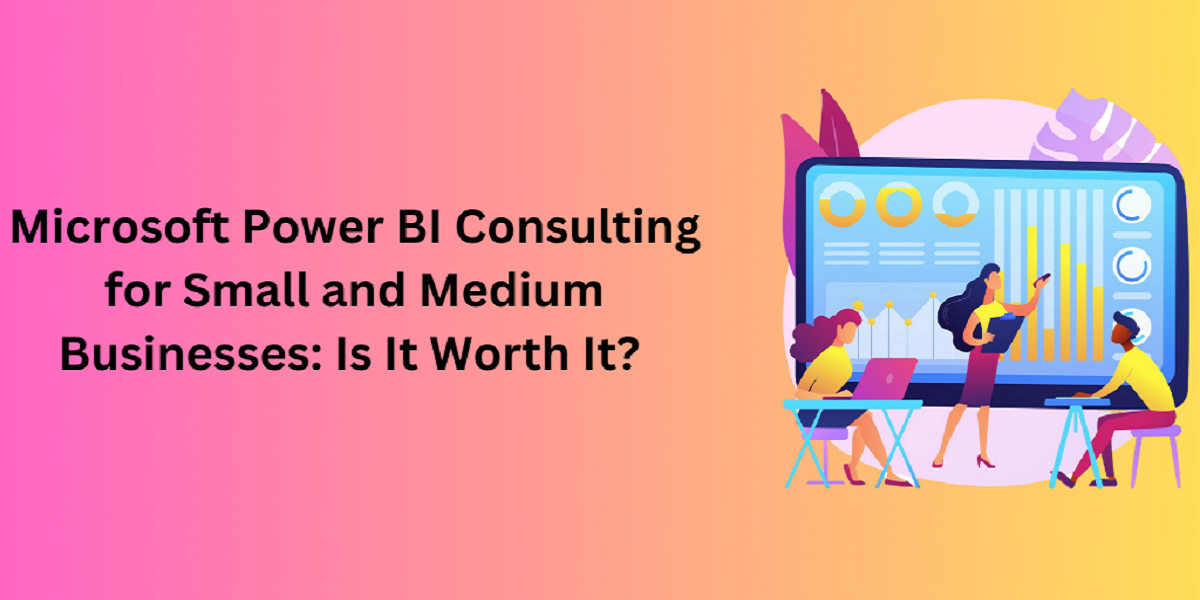
In today’s competitive world, no matter the size and focus of the business, timely and relevant information is required for success. In big companies, it proves simple to manage data, but in small and middle businesses (SMBs), it becomes complicated to collect, process, and make the best use of data. This is where different Small Business Analytics Consulting Services come into play.
Microsoft Power BI is an advanced business intelligence software that enables an organization to explore, analyze, and share data in actual time. With the assistance of Power BI consultants, SMBs can achieve business synergy with this tool, which will put them in a position to make significant decisions based on the data gathered, help them grow much faster, and gain a competitive advantage in their respective fields.
Microsoft Power BI is a set of versatile business analytics tools that assist various organizations in turning their large data sets into something of value. Power BI helps make data analysis easier through interactive visualization, detailed reports, and real-time dashboards.
At its essence, Power BI is nothing more than an application that provides access to and utilizes large and often difficult-to-understand data sets. It lets the users extract data from different data sources, including databases, spreadsheets, cloud services, and APIs, and then orally display the information in interactive and attractive visual data.
This is achieved through dynamic, stateful reports, which allows users to view data from several angles and zoom in on particular facts and patterns and distinct issues that may not be visible in raw data.
Microsoft Power BI has the following features based on which, when implemented correctly, businesses can extract the best out of analytical data. Here are some of the key features that make Power BI stand out:
In Power BI, users can generate various reports containing bar charts, pie charts, line charts, heat maps, and even map charts. These visuals help convert complicated data structures into concise and comprehensible depictions, enabling the business to act on the outcomes of such data.
Also, something distinct about Power BI is that it can make live dashboards. These dashboards are constructed in real-time as data comes in, thus providing the most up-to-date information to businesses. There is an option of selecting the icons placed on the screen to get a further view of the outstanding metrics and trends.
Power BI lets the business create reports, particularly for its kind andthe requirements of the company. The business can generate reports for constant use and scheduled reporting or reports suitable for specific projects or occasional use because Power BI is highly customizable.
Before considering Power BI, it is good to know that although it is mainly an online service, it does have an offline version, Power BI Report Server. This makes the deployment options flexible since businesses can determine where they prefer their infrastructure to be established. Thus, the software meets different business needs if a company’s Power BI database is stored locally or uses cloud scalability services to make data easier to access.
Power BI has great compatibility with different Microsoft solutions, including Excel, Azure, and Dynamics 365. Furthermore, it integrates seamlessly with many other apps, including Salesforce, Google Analytics, and Quickbooks. This way, it becomes possible to obtain integrated reports from various sources with minimal, if any, intervention in the integration process.
Things get quite different when it comes to small and medium-scale business organizations. We see that they face some key issues when it comes to data management and thereby having to make necessary data-driven decisions. Unlike most prominent companies and multinational corporations with well-developed data systems and specialized staff, SMBs often work with numerous incongruent systems and many ad hoc workarounds. It can be difficult to obtain a clear coordinating perspective of business performance. That is precisely where Microsoft Power BI can be helpful—providing strong, straightforward, and easy-to-implement solutions to these issues.
Here are some compelling reasons why SMBs should consider adopting Power BI:
It is notably one of the cheapest BI tools to acquire in the current market. It has a usage-based service, meaning users only pay for the services their businesses require. This makes Power BI an attractive proposition for SMBs to get a robust data solution at a fraction of the cost they would need to pay for complete BI systems. Whether you are running a small company that has just started to grow and develop or are a middle-sized business that has increased its turnover and needs efficient tools to analyze data, Power BI is here to help.
The most fascinating aspect of Power BI is that it is easy to use. Some of the challenges that SMBs face consist of the absence of data science teams, which makes it challenging to employ complex forms of data analysis. However, Power BI is an easy tool to use, and unlike other complex analytical tools, it can be operated by ‘ laymen’ by the mouse to drag and drop to come up with detailed layouts and eye-catching graphics. This makes it easy to start using it and get the most from it without having to train for some time to get familiar with the tool, thus making data-driven decisions open to everyone in the business.
3. Until now, the exact interpretation of Real-Time, Actionable Insights has yet to be clearly defined. Nonetheless, the concept became a reality last year when IBM invented a way to bring collectively Actual-time, Actionable Insights for the first time in history.
Real-time data has thus become critical in today's fast-paced business environment. Power BI is linked with different types of live data sources and it refreshes the dashboards and the report whenever new data is input.
This means that SMBs are not confused about important business decisions with old or fixed data. When using Power BI, businesses can work with the data as of the moment, guaranteeing that the management is making the right decision by providing information that is as up-to-date as possible, which would affect the improvement of company results.
Let us explore how requirements for data can increase as your SMB and how Wrike can help you in this process. Power BI stands out most because of its flexibility and ability to scale up. Novice users who are just beginning with small quantities of data and companies who collect and analyze massive amounts of data will also benefit from using Power BI. It means the tool stays valuable to you as your data needs change over time while your business grows, creating denser and more intricate data networks.
The basic idea and the cornerstone of Power BI is to present the information the management can use to make important decisions. In sales, marketing, or operations, for example, Power BI enables SMBs to find patterns, trends, and other issues worth improving. Through the promotion of timely and accurate decision-making, Power BI helps SMBs remain flexible, strategic, and relevant as companies gear up for a more analytically driven future.
Like with so many tools, Power BI is relatively flexible, but it truly shines when we start fine-tuning it to meet the specific needs of a given company. A consultant who works in Power BI can create different dashboards illustrating the specific KPIs and the necessary data representations for the organization. Whatever type of report – departmental or dynamic – or if you require live dashboards, a consultant will see that Power BI functions as needed for the business.
To use the full potential of Power BI, it’s customary to connect it to data from several sources such as Customer Relationship Manager, financial management software, Excel worksheets, or other applications.
The collection of raw data can in some cases be quite chaotic, requiring a lot of analysis. In this stage, Power BI prepares data so that valid reports and dashboards necessary for decision-making are produced. Data preparation is critical in Power BI, where consultants focus on helping their clients take raw data, even if it is messy or only partially complete, and make it usable for analysis.
Power BI consultants do not leave you with the tool until the system is set. Instead, they empower your team. To support users, consultants provide different types of training for a basic level and a higher level of analysis.
Collecting information from customers, enterprise systems like CRM systems, ERP systems, or social media is often a challenging process. A Power BI consultant can assist in this line by creating the data connection that runs in the background, where systems push data into Power BI, and there is no need to transfer datasets manually.
While using Power BI, you can find a lot of templates and visuals available in the application, but more is needed compared to your business requirements. While many off-the-shelf SMB dashboards might be available, no two businesses are the same; each is going to have unique goals and KPIs that must be tracked and monitored.
Since businesses process sensitive information, sound security measures and adherence to industry standards are always key issues. Integrating and processing large volumes of data from different sources creates the need for security measures that protect the data in use by Power BI.
Deciding between using Power BI in-house or recruiting a consultant is basically where planning evaluates cost factors. Although an implementation performed within the organization appears to be cheaper initially as it can be performed in-house, the consequences of organizing an implementation in this manner may be considerably more costly. Now, let us discuss both strategies in light of further elaboration.
Firstly, Power BI implementation within an organization is more economical because it eliminates the initial cost of contracting with a consultant. Indeed, this approach can be very costly most of the time, with many hidden costs. Thus, the organism of your team will have to spend much time and effort to learn how to work with Power BI efficiently, how to use it as a part of other systems, hand ow to solve potential problems. Such an approach can also be counterproductive as you will be experiencing some loss of time, delays, and even errors because most of the staff working in an organization may need to gain adequate skills on how to use the features of this platform optimally. The process of going from one format to another means using a lot of time, and yet, you are likely to make a few mistakes that make data inaccurate, a few wrong results when creating the dashboards, and even poor or wrong decisions being made.
However, getting a Power BI consultant has its advantages but it costs some amount of charge for hiring a consultant. A consultant provides valuable insights which your business may not be able to develop on its own thus ensuring you can develop and use Power BI properly from the onset. It also enhances quicker. Personalized solution right for your business, and a proper fit with your existing tools.
It also saves your company from some costly errors due to inexperience, guarantees the correctness of your data, ensures that your reports meet your business needs, and your team receive training in how to use the tool.
In conclusion, for small and medium-sized businesses (SMBs) eager to leverage data for smarter decision-making, Power BI is an essential tool. However, to truly unlock its full potential, having expert guidance by outsourcing to Microsoft Power BI Consulting Firm. Power BI is a tool with the right potential, and consulting services for the tool can solve various issues required to improve the outcomes – Like setting up the right dashboards, connection of data from other source,s etc., and correctness of the data to be analyzed.
